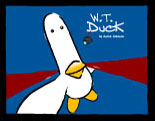
I found my chosen comic strip from the news section of the yahoo website. It comes from a series of comic strips entitled W.T. Duck written by Aaron Johnson. He publishes a new strip every day on a site named whattheduck.net. The comic strips cover a variety of comical subjects, and every one of them feature a duck working as a photographer as the main character. Another thing all of Johnsons strips have in common is they are always three frames in length. Sometimes each frame acts as a separate seen and other times, like in my chosen comic, the three frames act together as one.
As far as the context goes, we know that Aaron Johnsons main goal when making any of his comics is to have them be consistantly funny, so that in turn, websites like yahoo publish them daily. This helps Johnson to build his audience as well as make more money. The particular comic I chose was published on October 27 of this year, so we know that this comic is very recent and is likely rhetoricly dealing with issues of modern day society.
When I origionally saw the comic strip, I kind of had a clew that this series of comics always included a duck, just based on the title. What I didnt pick up untill after was that this duck was always a photogropher. It's hard to say for certain why Johnson chose this particular profession for the duck, but I would guess that a photogropher acts to represent bot the average working class American, as well as possibly just a third party observer of situations. After looking through some of Johnsons older comics, i also noticed that the cartoons included besides the duck are normally either another duck, or humans. In my chosen comic, he instead chooses to incorporate monsters. This is probably largely due to the fact that it is near holloween, but also could be that this comic pokes alittle at discrimination and it may have ben uncomfurtable to place human charactors in this situation.
The chosen medium is also a large factor in the context of this piece. When people see this text, they will likely be either brousing through comic strips in the newspaper or skimming through the comics page of some website. This means that the target audience will likely be in a sort of mood for laughter and comic relief. This is a far diferent situation then in Johnson was trying to make a point through the medium of writing a book or publishing an article, just beacuase people would not view it in the same light. Johnson uses the medium of a comic to discretly shape opinions of current issues he feels are important while the audience most of the time thinks they are just getting a good laugh.
